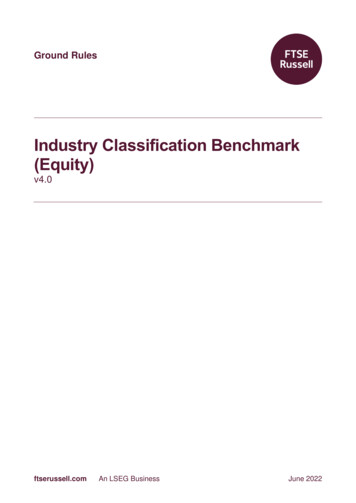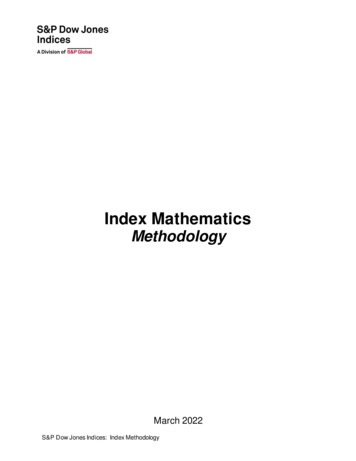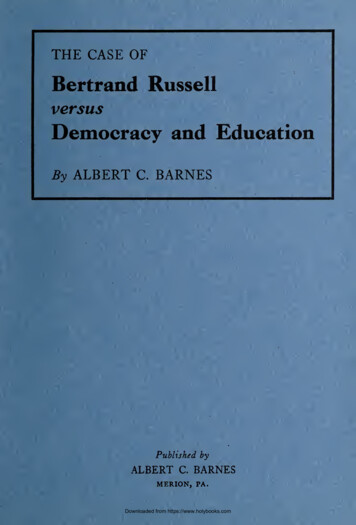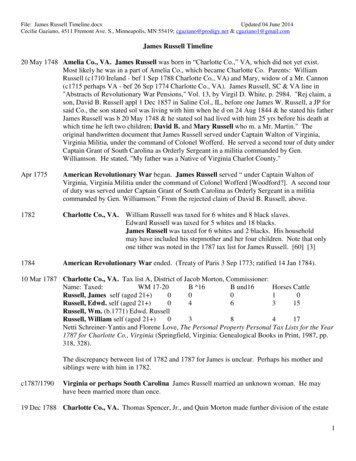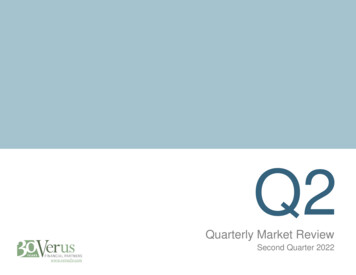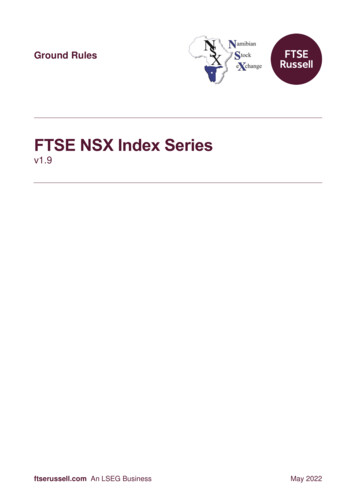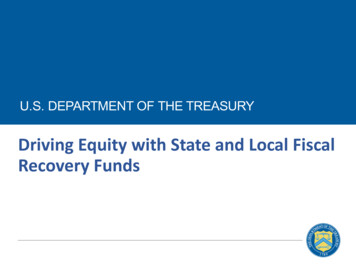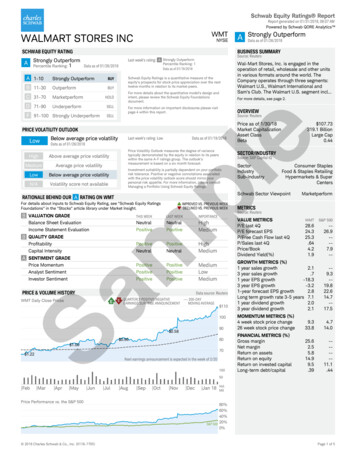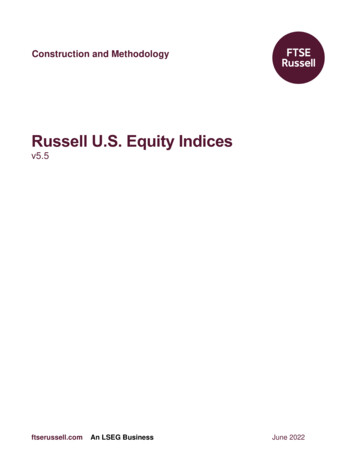
Transcription
Construction and MethodologyRussell U.S. Equity Indicesv5.5ftserussell.comAn LSEG BusinessJune 2022
Construction and MethodologyContents1.0Introduction .51.3FTSE Russell . 51.4Available indices. 62.0Management Responsibilities .82.1FTSE International Limited (FTSE) . 82.2Amendments to the Construction and Methodology . 83.1Queries, Complaints and Appeals . 93.2Index Policy for Trading Halts and Market Closures . 93.3Index Policy in the Event Clients are Unable to Trade a MarketError! Bookmark not defined.3.4Recalculation Policy and Guidelines . 103.5Policy for Benchmark Methodology Changes . 103.6FTSE Russell Governance Framework. 104.0Basic Methodology . 114.2Annual reconstitution. 114.3Quarterly initial public offerings . 115.0Defining Eligible Securities. 145.2Determining U.S. Companies . 145.3Home-country indicators (HCIs) . 145.4Share Descriptions . 155.5Steps to determining U.S. country assignment: . 155.6Trading requirements . 165.7Exchange and Segment requirements . 165.8Minimum closing price . 165.9Minimum total market capitalization . 165.10Minimum available shares / float requirement . 165.11Company structure . 16FTSE Russell An LSEG Business Russell U.S. Equity Indices Construction and Methodology, v5.5, June 20222
5.12UBTI screening . 175.13Shares excluded . 175.14Deadline for inclusion . 175.15Minimum Voting Rights . 176.0Defining Membership by Size . 196.2Determining total shares outstanding . 196.3Determining price . 196.4Corporate actions impacting reconstitution ranking . 206.5Reconstitution . 206.6Corporate Actions . 206.7IPOs . 216.8Initial public offerings (IPOs) . 216.9Russell U.S. Indices IPO calendar: . 226.10Determining index membership . 226.11Steps in calculating percentile ranges of the new index: . 237.0Float . 258.0Determining Style . 268.2Russell Growth and Value Indices . 268.3Russell Defensive and Dynamic Indices . 278.4Quality Score (comprises 50% of the overall stability probability) . 288.5Volatility Score (comprises 50% of the overall stability probability) 288.6Description of non-linear probability algorithm . 298.75% rule . 298.8Banding rule . 298.9Market capitalization of growth/value and defensive/dynamic indices308.10Missing values, negative values, or low coverage . 309.0Timing and Treatment of Corporate Actions . 329.2“No replacement” rule . 33FTSE Russell An LSEG Business Russell U.S. Equity Indices Construction and Methodology, v5.5, June 20223
9.3Changes to shares outstanding and free float . 3310.0 Russell Equal Weight Indices . 3510.2Available indices. 3510.3Quarterly index re-weighting and annual reconstitution. 3610.4Corporate action–driven changes . 36Appendix A: Index Tickers and Base Values . 38Appendix B: Country Assignment Methodology Details . 41Appendix C: Sample Client Notification . 45Appendix D: Predictive Index Data . 47Appendix F: Performance Algorithms . 48Appendix G: Reconstitution Schedule . 50FTSE Russell An LSEG Business Russell U.S. Equity Indices Construction and Methodology, v5.5, June 20224
Section 1Introduction1.0Introduction1.1.1FTSE Russell provides float-adjusted, market capitalization–weighted indices for a precise picture ofthe market. Today, 9.1 trillion in assets are benchmarked to the Russell US indices.11.2The Russell US Equity Indices do not take account of ESG factors in the index design.1.3FTSE Russell1.3.1FTSE Russell is a trading name of FTSE International Limited, Frank Russell Company, FTSE GlobalDebt Capital Markets Limited (and its subsidiaries FTSE Global Debt Capital Markets Inc. and FTSEFixed Income Europe Limited), FTSE Fixed Income LLC, The Yield Book Inc and Beyond Ratings.1.3.2FTSE Russell hereby notifies users of the index series that it is possible that circumstances, includingexternal events beyond the control of FTSE Russell, may necessitate changes to, or the cessation of,the index series and therefore, any financial contracts or other financial instruments that referencethe index series or investment funds which use the index series to measure their performance shouldbe able to withstand, or otherwise address the possibility of changes to, or cessation of, the index.1.3.3Index users who choose to follow this index series or to buy products that claim to follow this indexseries should assess the merits of the index’s rules-based methodology and take independentinvestment advice before investing their own or client funds. No liability whether as a result ofnegligence or otherwise is accepted by FTSE Russell for any losses, damages, claims and expensessuffered by any person as a result of: any reliance on this Methodology, and/or any errors or inaccuracies in this Methodology, and/or any non-application or misapplication of the policies or procedures described in thisMethodology, and/or any errors or inaccuracies in the compilation of the index or any constituent data.1Data as of December 31, 2019 as reported on April 1, 2020 by eVestment for institutional assets, Morningstar for retail mutual funds,insurance products, and ETFs, and additional passive assets directly collected by FTSE Russell.FTSE Russell An LSEG Business Russell U.S. Equity Indices Construction and Methodology, v5.5, June 20225
1.4Available indices Capital and total return indices.Net total return indices based on specified withholding tax rates.Indices calculated in currencies other than the base currency (USD).Currency hedged indices.Capped indices; for full details see the FTSE Russell Capping Methodology guide.Constituent size bands – large, mid, small and micro capitalisation indices.Sector indices.Additional customised variants can be calculated on request including indices with industry, countryand sector exclusions. Selected indices are calculated and disseminated on a real time basis1.4.1All Russell U.S. equity indices are subsets of the Russell 3000E Index. A list of available tickers andindex values can be found in Appendix A.1.4.2Price, total, net, and hedged data for the Russell U.S. indices is available in the following currencies.Exchange rates used in the End of Day calculations are WM/Refinitiv Closing Spot Rates , collectedat 16:00 London time (further information on The WM/Refinitiv Closing Spot Rates service isavailable from The WM Company).1.4.3The base currency of the benchmark is US Dollars. Index values may also be published in othercurrencies.AUDCADCHFEURGBPJPYUSDSGDBroad market U.S. indicesLarge cap U.S. indicesMidcap U.S. indicesRussell 3000E IndexRussell 1000 IndexRussell Midcap IndexRussell 3000E Value IndexRussell 1000 Value IndexRussell Midcap Value IndexRussell 3000E Growth Index Russell 3000 Index Russell 3000 Value Index Russell Midcap Growth IndexRussell 1000 Growth Index Russell 1000 Defensive Index ZAR Russell Midcap Defensive Index Russell Midcap Dynamic Index Russell 1000 Dynamic Index Russell Midcap GrowthDefensive Index Russell 3000 Growth IndexRussell 1000 Growth-Defensive IndexRussell 3000 Defensive Index Russell 1000 Growth-Dynamic Index Russell Midcap Growth-DynamicIndex Russell 3000 Dynamic Index Russell 1000 Value-Defensive Index Russell Midcap Value-DefensiveIndex Russell 3000 Growth-DefensiveIndex Russell 1000 Value-Dynamic Index Russell Midcap Value-DynamicIndex Russell 3000 Growth-DynamicIndex Russell Top 200 IndexRussell 3000 Value-Defensive Index Russell Top 200 Value IndexRussell 3000 Value-Dynamic Index Russell Top 200 Growth IndexRussell Top 200 Defensive Index Russell Top 200 Dynamic Index Russell Top 200 Growth-Defensive Index Russell Top 200 Growth-Dynamic Index Russell Top 200 Value-Defensive Index Russell Top 200 Value-Dynamic Index Russell Top 50 Mega Cap IndexFTSE Russell An LSEG Business Russell U.S. Equity Indices Construction and Methodology, v5.5, June 20226
Small-mid U.S. indicesSmall cap U.S. indicesMicrocap U.S. indicesRussell 2500 IndexRussell 2000 IndexRussell Microcap Index Russell 2500 Value Index Russell 2500 Growth IndexRussell 2500 Defensive IndexRussell Microcap Value IndexRussell 2000 Value IndexRussell Microcap Growth IndexRussell 2000 Growth Index Russell 2000 Defensive IndexRussell 2500 Dynamic Index Russell 2000 Dynamic Index Russell 2500 Growth-Defensive IndexRussell 2500 Value-Defensive Index Russell 2000 Growth-Dynamic Index Russell 2000 Value-Defensive Index Russell 2000 Value-Dynamic Index Russell 2500 Growth-Dynamic IndexRussell 2500 Value-Dynamic Index Russell 2000 Growth-DefensiveIndex Russell Small Cap Completeness IndexRussell Small Cap Completeness Value IndexRussell Small Cap Completeness Growth IndexFTSE Russell An LSEG Business Russell U.S. Equity Indices Construction and Methodology, v5.5, June 20227
Section 2Management Responsibilities2.0Management Responsibilities2.1FTSE International Limited (FTSE)2.1.1FTSE is the benchmark administrator of the index.22.1.2FTSE Russell is responsible for the daily calculation, production and operation of the index seriesand will: maintain records of the index weightings of all constituents; make changes to the constituents and their weightings in accordance with the Methodology; carry out the periodic index reviews of the index series and apply the changes resulting fromthe reviews as required by the Methodology; publish changes to the constituent weightings resulting from their ongoing maintenance andthe periodic reviews; disseminate the indices.2.2Amendments to the Construction and Methodology2.2.1This Construction and Methodology shall be subject to regular review by FTSE Russell to ensure thatthey continue to best reflect the aims of the index. Any proposals for significant amendments to theConstruction and Methodology will be subject to consultation with FTSE Russell advisory committeesand other stakeholders if appropriate. The feedback from these consultations will be considered bythe FTSE Russell Index Governance Board before approval is granted.2The term administrator is used in this document in the same sense as it is defined in Regulation (EU) 2016/1011 of the EuropeanParliament and of the Council of 8 June 2016 on indices used as benchmarks in financial instruments and financial contracts or tomeasure the performance of investment funds (the European Benchmark Regulation) and The Benchmarks (Amendment andTransitional Provision) (EU Exit) Regulations 2019 (the UK Benchmark Regulation).FTSE Russell An LSEG Business Russell U.S. Equity Indices Construction and Methodology, v5.5, June 20228
Section 3FTSE Russell Index Policies3.0FTSE Russell Index PoliciesThese Ground Rules should be read in conjunction with the following policy documents which can beaccessed using the links below:3.1Queries, Complaints and Appeals3.1.1A constituent or prospective constituent company (or professional advisor acting on behalf of thecompany), a national organization or a group of no fewer than ten users of the Indices from differentorganizations acting in their professional capacity may appeal against decisions taken by FTSERussell.FTSE Russell’s complaints procedure can be accessed using the following link:Benchmark Determination Complaints Handling Policy.pdfFTSE Russell’s Appeal Process can be accessed using the following link:Appeals Against Decisions.pdf3.2Index Policy for Trading Halts and Market Closures3.2.1Guidance for the treatment of index changes in the event of trading halts or market closures can befound using the following link:Index Policy for Trading Halts and Market Closures.pdf3.1Index Policy in the Event Clients are Unable to Trade a Market or a Security3.1.1Details of FTSE Russell’s treatment can be accessed using the following link:Index Policy in the Event Clients are Unable to Trade a Market or a Security.pdfFTSE Russell An LSEG Business Russell U.S. Equity Indices Construction and Methodology, v5.5, June 20229
3.2Recalculation Policy and Guidelines3.2.1The Russell US Equity Indices are recalculated whenever errors or distortions occur that are deemedto be significant. Users of the Russell US Equity Indices are notified through appropriate media.For further information refer to the FTSE Russell Recalculation Policy and Guidelines documentwhich is available from the FTSE Russell website using the link below or by contactinginfo@ftserussell.com.Equity Index Recalculation Policy and Guidelines.pdf3.3Policy for Benchmark Methodology Changes3.3.1Details of FTSE Russell’s policy for making benchmark methodology changes can be accessed usingthe following link:Policy for Benchmark Methodology Changes.pdf3.4FTSE Russell Governance Framework3.4.1To oversee its indices, FTSE Russell employs a governance framework that encompasses product,service and technology governance. The framework incorporates the London Stock ExchangeGroup’s three lines of defence risk management framework and is designed to meet therequirements of the IOSCO Principles for Financial Benchmarks 3, the European benchmarkregulation4 and the UK benchmark regulation5. The FTSE Russell Governance Framework can beaccessed using the following link:FTSE Russell Governance Framework.pdf3IOSCO Principles for Financial Benchmarks Final Report, FR07/13 July 2013Regulation (EU) 2016/1011 of the European Parliament and of the Council of 8 June 2016 on indices used as benchmarks in financialinstruments and financial contracts or to measure the performance of investment funds5The Benchmarks (Amendment and Transitional Provision) (EU Exit) Regulations 20194FTSE Russell An LSEG Business Russell U.S. Equity Indices Construction and Methodology, v5.5, June 202210
Section 4Basic Methodology4.0Basic Methodology4.1.1Russell indices are objectively constructed and based on transparent rules. The broadest U.S. index isthe Russell 3000E Index, which contains the largest 4,000 U.S. companies. Sub-indices in the Russell3000E Index are broken out by market capitalization and style.4.1.2The members of the Russell 3000E Index and its subsets are determined each year during annualreconstitution and enhanced quarterly with the addition of initial public offerings (IPOs).4.2Annual reconstitution4.2.1Annual reconstitution is the process by which all Russell indices are completely rebuilt. Reconstitution isa vital part of the creation of a benchmark that accurately represents a particular market segment.Companies may get bigger or smaller over time, or periodically undergo changes in their stylecharacteristics. Reconstitution ensures that companies continue to be correctly represented in theappropriate Russell indices.4.2.2On the rank day in May each year, all eligible securities are ranked by their total market capitalization.The largest 4,000 become the Russell 3000E Index, and the other Russell U.S. indices are determinedfrom that set of securities. If there are not 4,000 eligible securities in the U.S. market, the entire eligibleset is included.4.2.3Reconstitution occurs on the fourth Friday in June. A full calendar for reconstitution is published eachspring, although the guidelines which define the schedule are available in Appendix G.4.3Quarterly initial public offerings4.3.1Eligible initial public offerings (IPOs) are added to Russell indices quarterly in accordance with theschedule in Section 6. FTSE Russell adds IPOs each quarter to ensure that new additions to theinstitutional investing opportunity set are reflected in representative indices. FTSE Russell focuses onIPOs each quarter because it is important to reflect market additions between reconstitution periods.Companies filing an initial public offering registration statement (or the local equivalent when outside theU.S.) and listing within the same quarter* on an eligible US exchange are reviewed for eligibilityregardless of previous trading activity (exceptional or unique events may induce extraordinary treatmentFTSE Russell An LSEG Business Russell U.S. Equity Indices Construction and Methodology, v5.5, June 202211
which will be communicated appropriately). Companies currently trading on foreign exchanges or OTCmarkets will be reviewed for eligibility if: The company files an Initial Public Offering statement for an eligible US exchangeThe offering is announced to the market and confirmed by our vendors as an IPO* a one month window will be used to ensure that companies submitting the requisite filings just outsideof the quarter are not excluded from eligibility.To ensure that the requisite number of shares are available to satisfy the inclusion criteria and to ensurean accurate company weighting within the index calculation, FTSE Russell will distinguish between fullyguaranteed IPOs, variable/best effort IPOs, and direct listing IPOs as follows:4.3.2Fully Guaranteed IPOs (i.e. underwritten) 4.3.3The free float is assigned based on the post IPO shareholder structure contingent on this informationbeing publicly available and disclosed in the appropriate filings prior to the IPO rank date. Otherwise,the free float will be based on the number of shares publicly offered at the time of the IPO.Variable/Best Effort/Direct Listing IPOs Variable, best effort, and direct listing IPOs will be considered for index inclusion at the nextquarterly review if, by the IPO cut-off date, a public disclosure* (which has been published post IPO)is available confirming the IPO updated shareholder structure. Index inclusion remains subject tomeeting all other eligibility criteria. If the post IPO shareholder structure has not been disclosed bythe IPO cut-off date, the evaluation of the company will be deferred to the subsequent quarterlyreview. If no disclosure is published prior to the IPO cut-off date of the following quarter, thecompany will be evaluated at the Annual Reconstitution only (and inclusion will remain contingent onthe above disclosures)**.**For illustration purposes:For the December 2021 review, a variable, best effort, or direct listing IPO which listed on 22October 2021, will be required to disclose, post IPO, its updated shareholder structure by theDecember 2021 review IPO cut-off (i.e. 12 November 2021).If there is no disclosure prior to this date, the company will not be eligible for inclusion at theDecember 2021 review and will be reassessed at the next review in June 2022.If a published post IPO shareholder structure is not published prior to the June 2022 review IPO cutoff (i.e. 11 February 2022), the company will no longer be considered as a potential IPO addition andwill instead be evaluated during the Annual Reconstitution process only.For the avoidance of doubt: Shares which are locked up during the IPO will be considered for inclusion within the free float ofa company only once the lock up has expired. Green shoes (underwriter overallotment options) will only be considered for inclusion within thefree float of a company once the green shoe has been exercised and publicly confirmed(confirmation must be available on or prior to the rank date).FTSE Russell An LSEG Business Russell U.S. Equity Indices Construction and Methodology, v5.5, June 202212
4.3.4SPAC IPOs If an unlisted Special Purpose Acquisition Company (“SPAC”) acquires a target company, becomesan eligible company structure, and files an IPO registration statement and lists, all in the samequarterly window, then the company will be considered an IPO for the purposes of index inclusion.If an unlisted SPAC files an IPO registration statement and lists; then acquires a target company andbecomes an eligible company structure; and files another registration statement, all in the samequarterly window, then the company will be considered an IPO.If a listed SPAC (which listed prior to the current quarterly window), acquires a target company andsubsequently files another registration statement, the company will not be considered an IPO.FTSE Russell An LSEG Business Russell U.S. Equity Indices Construction and Methodology, v5.5, June 202213
Section 5Defining Eligible Securities5.0Defining Eligible Securities5.1.1Russell U.S. indices capture approximately 99% of the U.S. equity market and 100% of the investableU.S. market. Below are the requirements for securities’ inclusion in the Russell U.S. indices.5.2Determining U.S. Companies5.2.1Historically, asset owners have diversified their risk by assigning assets to specific countries. Somecompanies incorporate in a specific country for tax reasons, while some companies choose betteraccess to capital. Therefore, to most closely track country risk, FTSE Russell uses objective criteria toassign companies to the U.S. equity market. All companies that are determined to be part of the U.S.equity market are included in the Russell U.S. indices.5.3Home-country indicators (HCIs)5.3.1If a company incorporates in, has a stated headquarters location in, and also trades on a standardexchange6 in the same country (ADRs and ADSs are not eligible), the company is assigned to itscountry of incorporation. If any of the three criteria do not match, Russell then defines three homecountry indicators (HCIs). The HCIs are as follows:1. Country of incorporation2. Country of headquarters3. Country of the most liquid exchange as defined by two-year average daily dollar trading volume(ADDTV) from all exchanges within a country5.3.2After the HCIs are defined, the next step in the country assignment involves an analysis of assets bylocation. FTSE Russell cross-compares the primary location of the company’s assets with the threeHCIs. If the primary location of assets matches ANY of the HCIs, then the company is assigned to itsprimary asset location (see Appendix B for specifics on the definition of primary asset/revenue location).5.3.3If there is not enough information to determine a company’s primary location of assets, FTSE Russelluses the primary location of the company’s revenue for the same cross-comparison and assigns theStandard Exchanges are considered to be those listed in Appendix A ‘Eligible Exchanges and Market Segments’ of the FTSE Global EquityIndex Series Ground Rules as well as the Toronto Stock Exchange Venture Market.6FTSE Russell An LSEG Business Russell U.S. Equity Indices Construction and Methodology, v5.5, June 202214
company to the appropriate country in a similar fashion. FTSE Russell uses an average of two years ofassets or revenue data for analysis to reduce potential turnover.5.3.4If conclusive country details cannot be derived from assets or revenue, FTSE Russell assigns thecompany to the country in which its headquarters are located unless the country is a Benefit DrivenIncorporation (BDI) country (see Appendix B for a list of BDI countries). If the country in which itsheadquarters are located is a BDI, the company is assigned to the country of its most liquid stockexchange.5.3.5If a company is designated as a Chinese “N Share”, it will not be considered for inclusion within theRussell US Indices. An N Share is a company incorporated outside of mainland China that trades on theNew York Stock Exchange, the NASDAQ Exchange or the NYSE American. An N Share will have aheadquarters or Principle Executive Office or its establishment in mainland China, with the majority of itsrevenue or assets derived from the PRC. Further information regarding the designation of N shares isavailable within Appendix B.5.4Share Descriptions5.4.1For a description of Chinese share classes please see the “Guide to Chinese Share Classes” documentwhich can be accessed using the following link:Guide to Chinese Share Classes.pdf5.4.2The definitions these share classes are reviewed annually in September.5.5Steps to determining U.S. country assignment:STEP 1Is the company incorporated in,traded in, and headquartered in oneunique country?YES –Classified in the uniquecountryNO –Move to Step 2STEP 2Are the company’s reported assetsprimarily located in one of the HCIs?YES –Classified in the country ofprimary assetsNO –Move to Step 3STEP 3Are the company’s reported revenuesprimarily derived from one of the HCIs?YES –Classified in the country ofprimary revenueNO –Move to Step 4STEP 4Is the company headquartered in a nonBDI country?YES –Classified in the country ofheadquartersNO –Assigned to primaryexchange countryNote: If the company does not trade on a major U.S. exchange it is not eligible.Example 1: XYZ CompanyHCIs:Incorporation: U.S.Headquarters: ChinaTrading locations: U.S., U.K., Hong Kong (most liquid exchange: U.S.)Asset location: 100% in CanadaSTEP1Is the company incorporated in, tradedin, and headquartered in one uniquecountry?NO –Move to Step 2STEP2Are the company’s reported assetsprimarily located in the one of the HCIs?NO – CanadaMove to Step 3STEP3Are the company’s reported revenuesprimarily located in one of the HCIs?NO – No DataMove to Step 4FTSE Russell An LSEG Business Russell U.S. Equity Indices Construction and Methodology, v5.5, June 202215
STEP4Is the company headquartered in a nonBDI country?YES – ChinaCLASSIFICATION: ChinaExample 2: ABC CompanyHCIs:Incorporation: IrelandHeadquarters: IrelandTrading locations: U.S., Ireland, Germany (most liquid exchange: U.S.)Asset location: 85% in U.S.STEP1Is the company incorporated in,traded in, and headquartered in oneunique country?YES – IrelandAssigned to Ireland5.6Trading requirements5.6.1All securities eligible for inclusion in Russell U.S. indices must trade on an eligible U.S. exchange.Bulletin board, pink sheet or over-the-counter (OTC) traded securities are not eligible for inclusion,including securities for which prices are displayed on the FINRA ADF.5.7Exchange and Segment requirements5.7.1In construction of its equity indices, FTSE Russell reviews each exchange considering closingmechanism, availability of real-time prices, regulatory requirements for each exchange segment,settlement, trading rules and recognition of the exchange by the governing regulatory body. Followingreview of US exchanges, the following markets are deemed eligible. There is no minimum number ofsecurities required for the Russell U.S. indices.Eligible U.S. Exchanges: CBOE, NYSE, NYSE American, NASDAQ, ARCA.5.8Minimum closing price5.8.1A stock must have a close price at or above 1.00 (on its primary exchange) on rank day in May to beconsidered eligible for inclusion. In order to reduce unnecessary turnover, if an existing index member’sclosing price is less than 1.00 on rank day in May, it will be considered eligible if the average of thedaily closing prices (from its primary exchange) during the 30 days prior to the rank date is equal to orgreater than 1.00. If an existing index member does not trade on the rank day in May, it mus
FTSE Russell An LSEG Business Russell U.S. Equity Indices Construction and Methodology, v5.5, June 2022 7 Small-mid U.S. indices Small cap U.S. indices Microcap U.S. indices Russell 2500 Index Russell 2000 Index Russell Microcap Index Russell 2500 Value Index Russell 2000 Value Index Russell Microcap Value Index Russell 2500 Growth Index Russell 2000 Growth Index Russell Microcap .

